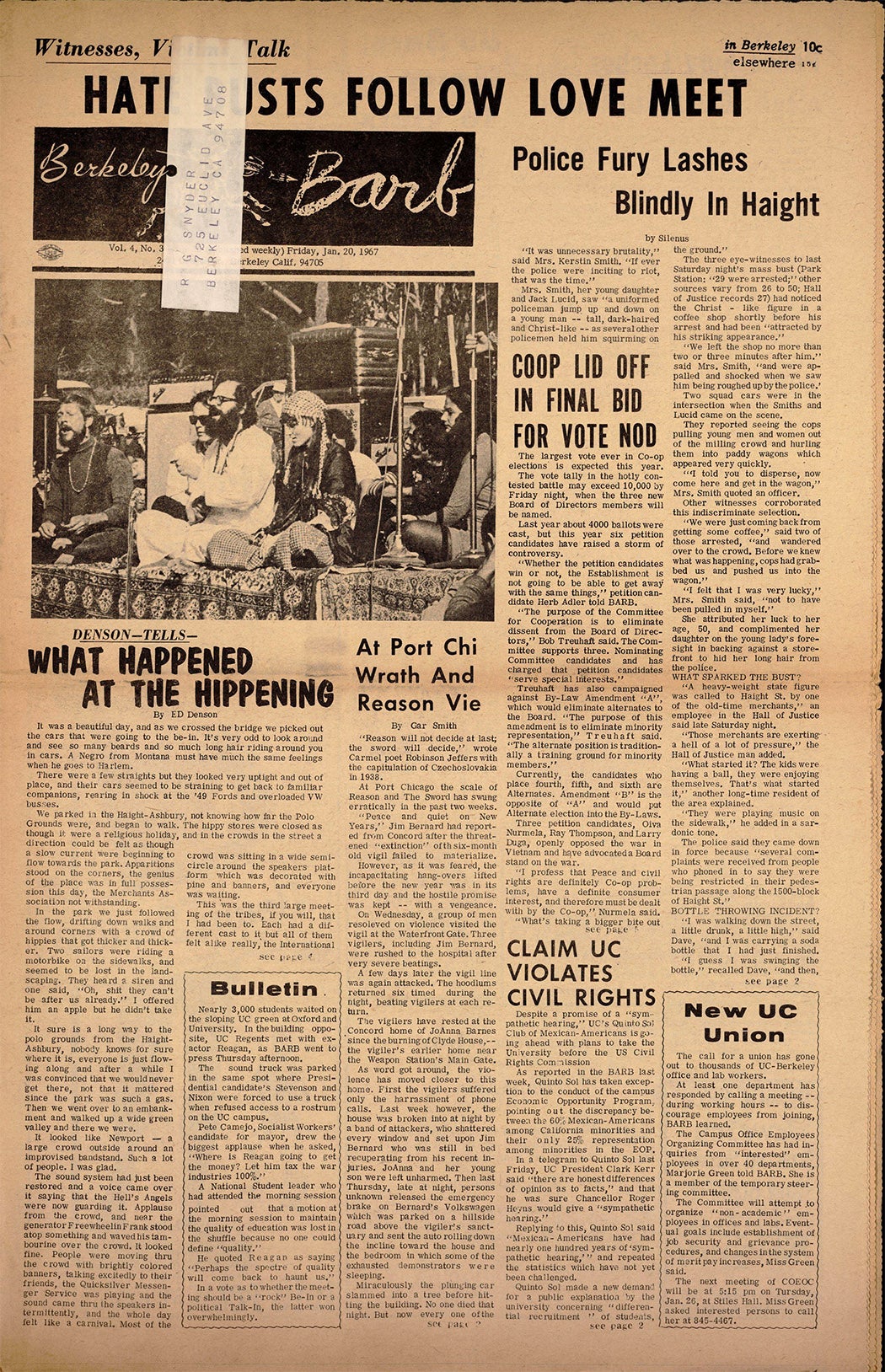On January 14, 1967, more than 20,000 hippies and participants in the counterculture gathered in San Francisco’s Golden Gate park to do little more than simply “be” together. The event cemented San Francisco’s Haight-Ashbury district as a center of countercultural activity, setting the stage for the thousands of youth—and the media blitz—that descended on the city in the Summer of Love in 1967.
At the Be-In, emerging countercultural leaders like Allen Ginsberg, Timothy Leary, Gary Snyder, and Jerry Rubin each spoke briefly (for about 15 minutes, so as not to turn the event into a rally). San Francisco rock bands like The Jefferson Airplane, Big Brother and the Holding Company, and The Grateful Dead performed. Issues of the San Francisco Oracle were passed around freely. A parachuter, rumored to have been the famous chemist and manufacturer of LSD, Stanley Owsley III, distributed free tabs of LSD. For many, like participant Helen Swick Perry, the Be-In was something like a religious event. Perry calls it a day in which she was initiated into a “new religion,” adding that “It was a religious rite in which nothing particular happened.”

Organizers of the San Francisco Be-In intended for the event to bring together what they believed at the time were related but disparate movements: the lifestyle hippies of Haight-Ashbury and the politically-oriented countercultural movement in Berkeley. The organizers of the event wanted these groups to become more familiar with one another, to see that they were of similar mindsets. They wanted them to simply be together. Larry Freudiger of Austin’s the Rag writes of the Be-in: “The revolutionary and the asocial elements have long needed to bridge the artificial boundaries between them, and judging from recent news, they’ve done it.”
To promote the event, Allen Cohen of the psychedelic newspaper the San Francisco Oracle reached out to the more politically-minded editors of underground newspapers: Max Scherr of the Berkeley Barb and Art Kunkin of the Los Angeles Free Press. Although the perception has persisted that lifestyle hippies and political revolutionaries were disparate parts of the counterculture, many were, to a greater or lesser extent, participants in both movements shared ideas and ideals with the others. The intentions behind the Be-In show how, even then, people saw themselves as part of both movements.
The Be-In took its inspiration from a number of historical occurrences—the famous sit-ins of the civil rights movements, the demonstration against the prohibition of LSD called the “Love Pageant Rally,” and, as Fred Turner notes, from the development of “happenings” that emerged out of postwar American liberalism.
San Francisco’s Be-In was only the first in a series of countercultural “-ins.” Multiple “Be-Ins” and “Love-Ins” followed all over the country. Underground papers were central actors in organizing, advertising, and documenting what happened at all of these gatherings.
Be-ins and love-ins became one of the central ways for participants in the counterculture to get to know one another, to create culture together. They were also central for making the political presence of the counterculture felt in cities and towns with much smaller countercultural communities than San Francisco’s or New York’s.
Weekly Newsletter
The Human Be-In was revived in 1989 with the first digital Be-In, intended to celebrate digital art and the burgeoning computer industry. On January 14, 2017, the Unity Foundation and “the Digital Be-In” launched a fiftieth anniversary campaign commemorating the “Summer of Love” in San Francisco, which was promoted by the California Historical Society and SF Travel. It was attended by well-known countercultural clown Wavy Gravy and messages were delivered digitally by Peter Coyote, Paul McCartney, Ringo Starr, and Dr. Jane Goodall. Although not free like the first one, the digital Be-In takes its inspiration from and is modeled after the original.
In addition to documentation of the San Francisco “Human Be-In,” the Independent Voices collection includes documentation of gatherings held in Ann Arbor, Chicago, Atlanta, and Austin.
Support JSTOR Daily! Join our new membership program on Patreon today.







